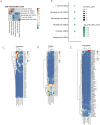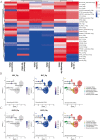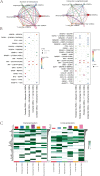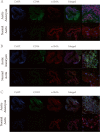Single-cell RNA sequencing reveals the vascular smooth muscle cell phenotypic landscape in aortic aneurysm
- PMID: 37189183
- PMCID: PMC10184349
- DOI: 10.1186/s12964-023-01120-5
Single-cell RNA sequencing reveals the vascular smooth muscle cell phenotypic landscape in aortic aneurysm
Abstract
Background and objectives: Phenotypic switching in vascular smooth muscle cells (VSMCs) has been linked to aortic aneurysm, but the phenotypic landscape in aortic aneurysm is poorly understood. The present study aimed to analyse the phenotypic landscape, phenotypic differentiation trajectory, and potential functions of various VSMCs phenotypes in aortic aneurysm.
Methods: Single-cell sequencing data of 12 aortic aneurysm samples and 5 normal aorta samples (obtained from GSE166676 and GSE155468) were integrated by the R package Harmony. VSMCs were identified according to the expression levels of ACTA2 and MYH11. VSMCs clustering was determined by the R package 'Seurat'. Cell annotation was determined by the R package 'singleR' and background knowledge of VSMCs phenotypic switching. The secretion of collagen, proteinases, and chemokines by each VSMCs phenotype was assessed. Cell‒cell junctions and cell-matrix junctions were also scored by examining the expression of adhesion genes. Trajectory analysis was performed by the R package 'Monocle2'. qPCR was used to quantify VSMCs markers. RNA fluorescence in situ hybridization (RNA FISH) was performed to determine the spatial localization of vital VSMCs phenotypes in aortic aneurysms.
Results: A total of 7150 VSMCs were categorize into 6 phenotypes: contractile VSMCs, fibroblast-like VSMCs, T-cell-like VSMCs, adipocyte-like VSMCs, macrophage-like VSMCs, and mesenchymal-like VSMCs. The proportions of T-cell-like VSMCs, adipocyte-like VSMCs, macrophage-like VSMCs, and mesenchymal-like VSMCs were significantly increased in aortic aneurysm. Fibroblast-like VSMCs secreted abundant amounts of collagens. T-cell-like VSMCs and macrophage-like VSMCs were characterized by high chemokine levels and proinflammatory effects. Adipocyte-like VSMCs and mesenchymal-like VSMCs were associated with high proteinase levels. RNA FISH validated the presence of T-cell-like VSMCs and macrophage-like VSMCs in the tunica media and the presence of mesenchymal-like VSMCs in the tunica media and tunica adventitia.
Conclusion: A variety of VSMCs phenotypes are involved in the formation of aortic aneurysm. T-cell-like VSMCs, macrophage-like VSMCs, and mesenchymal-like VSMCs play pivotal roles in this process. Video Abstract.
Keywords: Aortic aneurysm; Phenotypes; Single-cell transcriptome analysis; Vascular smooth muscle cells.
© 2023. The Author(s).
Conflict of interest statement
The authors declare no conflicts of interest.
Figures








References
Publication types
MeSH terms
Substances
LinkOut - more resources
Full Text Sources
Medical
Miscellaneous

